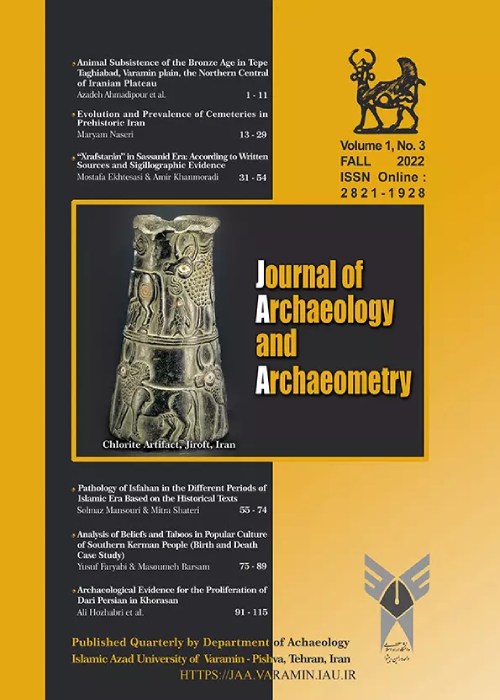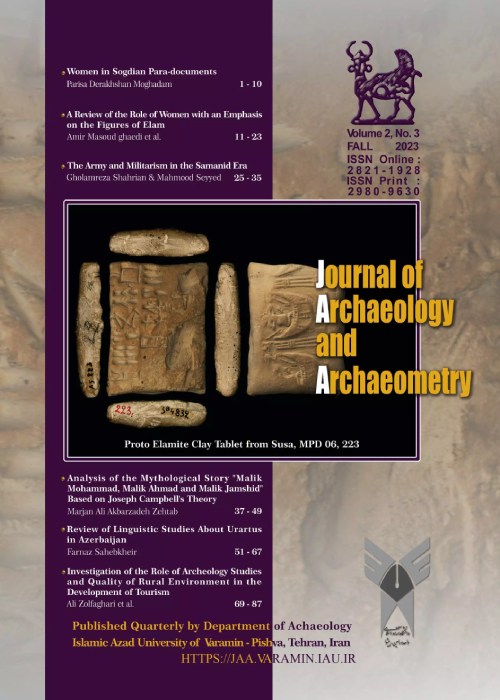فهرست مطالب

Journal of Archeology and Archaeometry
Volume:1 Issue: 3, Dec 2022
- تاریخ انتشار: 1401/11/02
- تعداد عناوین: 6
-
Pages 1-11Animal remains from Taghiabad in the Varamin plain are analyzed, conducted in 2018. This site is located north of Taghiabad and south of Ajorbast villages, Javadabad district in Varamin town. All the excavated bones are of animal origin, and no human bones have been retrieved. This site dates back to the Iron and Bronze ages; in this study, we deal with Bronze Age. Two hills were excavated, which are referred to as Taghiabad 1 and 2. Taghiabad 1 relates to the recent and middle Bronze Ages, containing ten loci (Seven loci of the Late and three loci of the Middle Bronze Age, respectively), and Taghiabad 2 contains three loci of the Late Bronze Age. Burning and cutmarks were found on some of the bones, which cutmarks might be secondary to butchery. This study is based on field, and lab studies on animals remain retrieved from these two hills (Taghiabad 1 and Taghiabad 2). Results show that sheep, goat, cattle, gazelle, equid, deer, and canine in Taghiabad 1 and sheep, cattle, gazelle, and small carnivorous in Taghiabad 2 are the most prevalent findings. The people’s primary sources of meat supplies were sheep, goats, and cattle.Keywords: Animal Species, Subsistence, Bronze Age, Iron age
-
Pages 13-29
The tradition of burial, so-called interment, is one of the most prominent manifestations of man›s long-standing view of death. Although this tradition has a very long history, it has witnessed many changes and ups and downs along its path till now. The study of these developments can reveal various political, social, environmental, cultural, and religious aspects of different ethnic groups. The purpose of this study is to investigate other elements of cemetery emergence in the prehistoric period of Iran and identify the factors affecting the occurrence of this phenomenon as a public space for the burial of bodies outside the sites. This research data has been collected through library studies and according to archaeological, anthropological, and sociological evidence. Data analysis shows that, firstly, in prehistoric times, at a glance, no specific factor could be considered for the emergence of cemeteries. Because the time and nature of the formation of cemeteries in regions of Iran are different and have gone through a completely different process, instead of asking a general question, the following question should be considered: what are the factors affecting the formation of cemeteries? Factors influencing the formation of cemeteries should be regarded in their context and geographical location because most of them do not offer a single perspective, and each one is created with specific meanings and goals. The findings also indicate various geographical, environmental, economic, political, and social reasons for the emergence and evolution of cemeteries.
Keywords: Burial, Cemetery, Factors of Emergence, Interment, Prehistory -
Pages 31-55“Evil animals” (MP. xrafstar, Av. xrafstra-) are harmful animals created by Ahriman to assist in destroying the world. Pahlavi scriptures present fragments of knowledge on various types of xrafstarân, some regulations and recommendations on how to crush them, and examples of divine reward for those believers who eradicate these evil animals. However, Pahlavi scriptures put urging stress on eliminating xrafstarân, sigillographic evidence from the Sassanid era points to the other direction, showing that in many cases, the Zoroastrian principle of destroying evil animals is ignored, to the extent that images of venomous animals could be seen on seals and sigils belonging to Zoroastrian priests and other elites of the Sassanid era. While in some cases, themes depicted on seals are by the religious recommendations of scriptures, owners’ personal preferences seem to remain the main factor in displaying images on seals. This question remains that depicting an evil animal on a personal seal contradicts religious regulations in Zoroastrianism. This opposition could be caused by diversity in interpretations of scriptures or by the co-existence of various factions of Zoroastrianism. The presence of other religions all over the Sassanid Empire could be one more cause of this discord. Through a comparison between depictions on seals and Pahlavi scriptures, the current study concludes that several images of xrafstarân depicted on seals are related to religions other than Zoroastrian Mithraism, Judaism, Christianism, and even Gnosticism. Moreover, most Zoroastrian scriptures mentioning xrafstarân are written only after the Sassanid era. It seems likely that after the collapse of Sassanid dynastys, some Zoroastrian priests rearranged the classification of beneficent animals created by Ahura and evil animals created by Ahriman. Nonetheless, the vital role of geography and cultural diversity of each region of the vast Sassanid Empire could not be overlooked while studying the presence or absence of animal themes in depictions.Keywords: Xrafstar, Sassanid Seals, Zoroastrianism, Pahlavi scriptures
-
Pages 55-74Isfahan and its historical monuments have been repeatedly damaged and destroyed for a long time due to their unique strategic location. They are located on the highway from north to south and east to west of the central plateau of Iran. Factors that have played a role in damaging and destroying Isfahan›s historical monuments can be generally divided into two categories: natural elements and phenomena and human factors and behaviors. This study aimed to identify and categorize the causes of damage to the historical monuments of Isfahan from the beginning of the Islamic period to the Qajar period. To achieve this goal, two general questions arise: What are the main factors that have caused damage to the historical monuments of Isfahan during the Islamic era, and how can they be classified? Which harmful phenomena have caused Isfahan›s most severe destruction of historical monuments? To answer the questions, the destructive factors of Isfahan›s architectural works from the beginning of the Islamic period to the Qajar period have been studied. The research method is descriptive-analytical, and the data collection method is based on the study of historical-geographical sources, field observations, and existing works reports. The studies show that in addition to various factors, the most critical factors causing natural damage to historical monuments in Isfahan are drought, famine, earthquake, and the essential human characteristics; there have been internal or external wars and conflicts.Keywords: pathology, Natural injuries, Abnormal injuries, Islamic period
-
Pages 75-89The folk culture of southern Kerman tribes has a vibrant history, and examining the religious content of these rituals and beliefs can open a new perspective in anthropological studies and ethnography. In this geographical area, there have always been various taboos related to the rites of birth, death, and other daily activities that all people were required to observe these taboos. Following the taboos and publishing them guarantee the survival and cohesion of rural communities. There were nomads in the past. The primary purpose of this research is to introduce the beliefs and taboos in the rituals and folk beliefs of the people of southern Kerman. The main question is, what types of taboos exist in the behaviors and folk beliefs of the people of south Kerman, and how have they guaranteed the survival and cohesion of this region? The method of collecting information is "documents and fieldwork.” In the first step, the authors of this article conducted interviews with native and local people to identify the beliefs related to taboo matters. Then they were categorized according to their function in each section. In the next step, the data, while describing and compared with other parts of the world, have been analyzed and examined using articles and books related to this field.Keywords: Taboo, South of Kerman, birth, Death
-
Pages 91-115
Dari apparently began to spread in Greater Khorasan only in the aftermath of the Arab invasions of Iran. As the official language of the Sasanian court, it would experience a substantial proliferation following the shift in power from Ctesiphon and Fars to eastern Iran, particularly Khorasan, which appeared as a safe haven for the king and the prominent court families during the first two decades of the invasions. The question then arises as to the relation between the spread of Dari in Khorasan and the resettlement of western and southern Iranian populations in the eastern part of the collapsing empire. Our inquiry into the Sasanian-Islamic transition in quest of the fire temples that persisted in the early Islamic centuries led to the conclusion in view of the fluctuating numbers of coeval sites that the earlier harsh attacks had apparently forced inhabitants of southern Iran in particular Fars and Ctesiphon to take refuge in Khorasan, the land of Adur Burzen-Mihr Fire. In their new home, these refugees would adopt two different modes of subsistence, thereby settlement, systems: sedentary rural life, and nomadic lifestyle involving periodic moves within a certain area. This dichotomous approach would guarantee their survival. Among the manifold results of the late Sasanian peace treaties between the dehgâns and the Arabs was the preservation of Iranian culture and language in Khorasan, where it contributed to several advances. Several years of efforts by Iranian immigrants to revive architectural and poetic styles in Khorasan proved that they were triumphant in the cultural battleground despite of losing the actual battle.
Keywords: Sasanian period, Early Islamic, Dari Language, Fars, Khorasan


